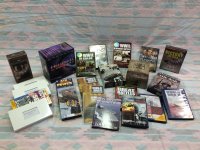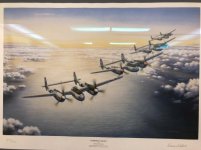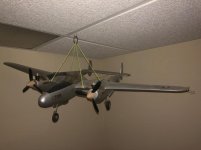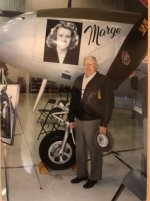I would enjoy them, but I would probably never take the time to watch.
However, you mentioned the "Bong Museum in Superior." That hit a sentimental spot.
Richard "Dick" Bong was the first Pacific Theater Ace, if I remember correctly. Why I know about him is because his photo and posters were all over Lockheed's 'Skunk Works' main engineering building in Burbank. He earned that ACE in a P-38 - 'The Forked Tail Devil,' as the enemy called it. He was a Lockheed hero, along with being a U.S. hero.
After he made Ace, the Army Air Corp brought him back to the U.S. They did not want him killed in action.
He was assigned to perform at air shows, etc., to help raise money through 'War Bonds,' I think. Unfortunately, he was killed in an aircraft accident. Here are the facts:
Richard I. Bong
The first of nine children, born in 1920 to a Swedish immigrant father and American-born mother, Dick Bong’s upbringing epitomized the values and expectations of that era – loyalty to his family and a deep sense of patriotism. Like all farm children, he had chores to perform and was expected to drive farm machinery at an early age. He hunted and fished in the surrounding woods and streams, played on his school athletic teams and sang in his church choir; as his 4H project he planted the extensive evergreen windbreak on the family farm, still in the family. At that time he modeled the ideal all-American boy.
Dick became enamored of flying as a small boy, watching planes fly over the farm carrying mail for President Calvin Coolidge’s summer White House in Superior. As a college student he learned to fly in the Civilian Pilot Training program; at the age of 20 he became a flying cadet in the US Army Air Corps, in time for the entry of America into World War II. Dick became America’s all-time Ace of Aces, downing 40 enemy planes in the Pacific theater of the war while flying P-38 fighter planes. His many decorations for outstanding skills and extraordinary courage included the Congressional Medal of Honor.
Dick was ordered home for his safety and married his sweetheart, Marge, in Superior. Six months later he was killed test piloting the first Lockheed jet fighter plane. His death at the age of 24 occured the same day that the atomic bomb was dropped on Hiroshima, yet he received banner headlines in the national newspapers.
Thousands attended Dick’s funeral services in Superior, and many more lined the funeral route to the Poplar cemetery, where he was buried in the family plot. In 1955, ten years after his death, a memorial was dedicated to Dick Bong in his hometown of Poplar, Wisconsin.
Ace of Aces
In 1944 Dick Bong was awarded the nation’s highest honor by General Douglas MacArthur, Commander of all U.S. Army units in the Far East, who said: “Major Richard Ira Bong, who has ruled the air from New Guinea to the Philippines, I now induct you into the society of the bravest of brave, the wearers of the Congressional Medal of Honor of the United States.”
Dick Bong, a hero in an era of heroes, represents a generation of young men and women who willingly left their farms, villages, and cities to defend their country’s freedom. They carried out the work that had to be done – and did it well.
Bong was the first fighter pilot handpicked by General George C. Kenney in the fall of 1942 for a P-38 squadron designed to strengthen his Fifth Air Force in Australia and New Guinea. Dick Bong loved flying and the P-38 was the ideal fighting plane for the combat techniques he mastered: swooping down on his targets and blasting them at dangerously close range, then pulling up fast. His own aircraft was damaged in battle in several of his missions, once so badly he had to crash-land.
General Kenney pulled Dick Bong out of combat when his score reached 40 and sent him home to “marry Marjorie and start thinking about raising a lot of towheaded Swedes.” Dick and Marge Vattendahl were married February 10, 1945 in Superior, an event attended by 1,200 guests and covered by the international press.
The couple honeymooned in California for several weeks before reporting to Wright-Patterson Air Force Base in Dayton, Ohio, where Dick began training for a new assignment in Burbank, California: testing the plane that would take the Air Force into the jet age – the Lockheed P-80 Shooting Star.
Dick Bong was intrigued by the new jet fighter and enthusiastic about his assignment. On August 6, 1945 (the day the Enola Gay dropped an atomic bomb on Hiroshima) Dick Bong was killed when the P-80 he was testing stalled and crashed on take-off.
Thanks for the memories - - - -
Joe T.







